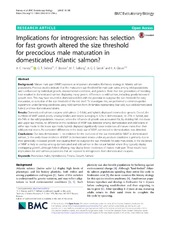| dc.description.abstract | Background: Mature male parr (MMP) represent an important alternative life-history strategy in Atlantic salmon populations. Previous studies indicate that the maturation size threshold for male parr varies among wild populations and is influenced by individual growth, environmental conditions, and genetics. More than ten generations of breeding have resulted in domesticated salmon displaying many genetic differences to wild salmon, including greatly increased growth rates. This may have resulted in domesticated fish with the potential to outgrow the size threshold for early maturation, or evolution of the size threshold of the trait itself. To investigate this, we performed a common-garden experiment under farming conditions using 4680 salmon from 39 families representing four wild, two wild-domesticated hybrid, and two domesticated strains. Results: Domesticated salmon outgrew wild salmon 2–5-fold, and hybrids displayed intermediate growth. Overall, the numbers of MMP varied greatly among families and strains: averaging 4–12% in domesticated, 18–25% in hybrid, and 43–74% in the wild populations. However, when the influence of growth was accounted for, by dividing fish into lower and upper size modes, no difference in the incidence of MMP was detected among domesticated and wild strains in either size mode. In the lower size mode, hybrids displayed significantly lower incidences of mature males than their wild parental strains. No consistent differences in the body size of MMP, connected to domestication, was detected. Conclusions: Our data demonstrate: 1- no evidence for the evolution of the size threshold for MMP in domesticated salmon, 2- the vastly lower incidence of MMP in domesticated strains under aquaculture conditions is primarily due to their genetically increased growth rate causing them to outgrow the size threshold for early maturation, 3- the incidence of MMP is likely to overlap among domesticated and wild salmon in the natural habitat where they typically display overlapping growth, although hybrid offspring may display lower incidences of mature male parr. These results have implications for wild salmon populations that are exposed to introgression from domesticated escapees. | en_US |

